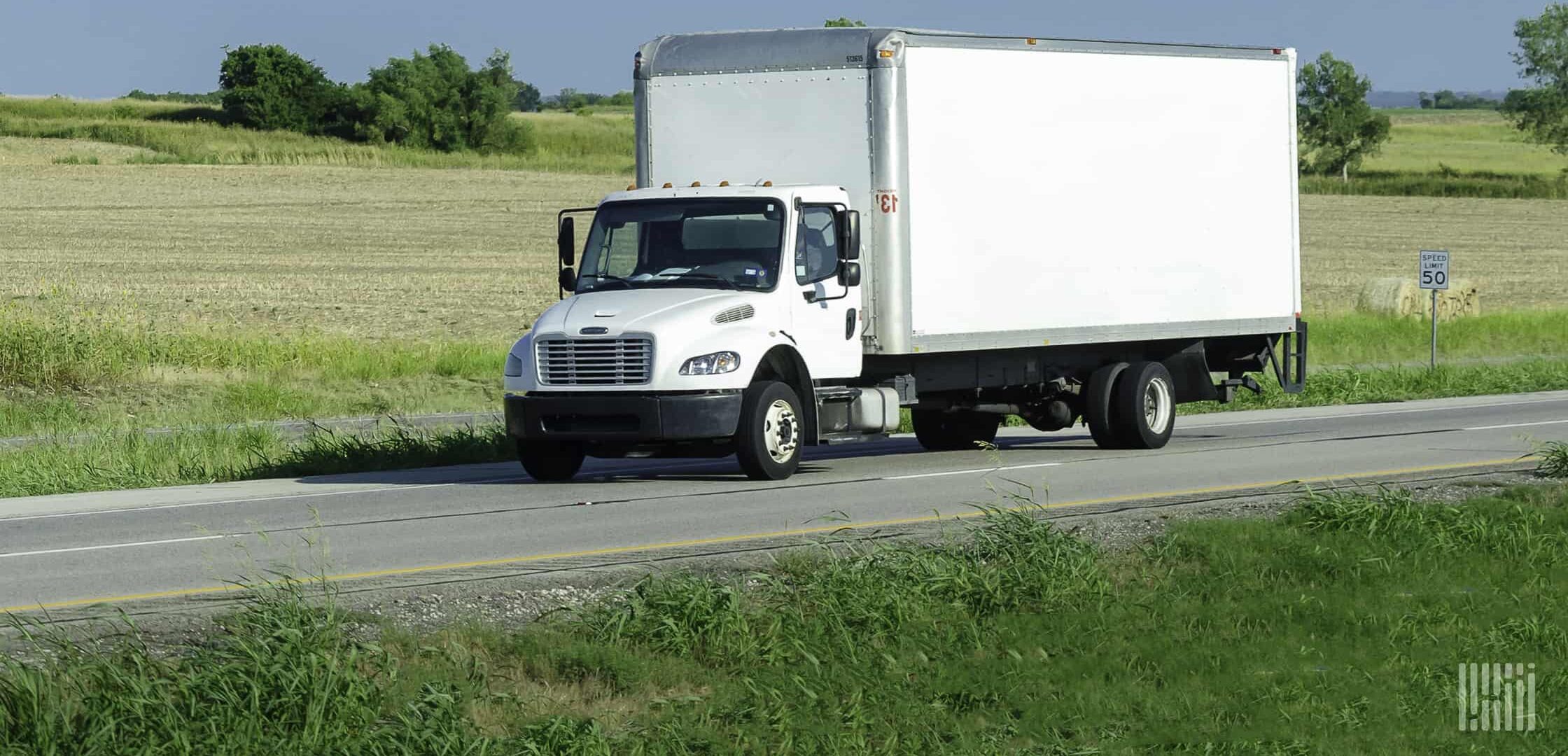A straight truck is like a semi truck with one key difference: the trailer cannot be removed. These vehicles work as an essential part of the logistics industry, usually on shorter routes. Examples of straight trucks include most types of U-Haul and dump trucks, along with UPS and FedEx delivery vehicles.
Straight trucks have several significant advantages for drivers. You don’t need a CDL license to drive a straight truck. As these vehicles are used on shorter delivery routes, drivers can return home in the evenings. Read on for types of straight trucks and the pros and cons of driving them.
And when you finish, be sure to read these other articles in our ‘How to find loads for box trucks’ article series:
- What’s a straight truck?
- Load boards for box trucks
- Where can I find loads for box trucks?
- How to find box truck freight brokers
Straight truck meaning
The Department of Transportation (DOT) and Federal Motor Carrier Safety Administration (FMCSA) define straight trucks as vehicles on which the cab and cargo area are mounted on a single frame or chassis. Also known as box trucks or cube vans, they are commonly used to transport goods over short to medium distances.
Because of their smaller size, they are easier to handle than a dry van semi truck and don’t require the same specialized training. Their greater maneuverability makes them well-suited for deliveries within urban areas.
What size is a straight truck?
Cube or straight truck vehicle sizes vary. They can range in length from 10 to 26 feet long. Height ranges from 8 to 10 feet. Their gross vehicle weight rating (GVWR) is between 6,001 to 14,000 pounds, which is vehicle Class III or Class IV. By contrast, light heavy-duty pickup trucks, like a Ford F-250 or RAM 2500, have a GVWR of 8,501 to 10,000 pounds.
Straight truck capacity
The capacity of a straight truck varies depending on its size, configuration, and purpose. Their volume capacity is typically between 500 to 1,800 cubic feet. From a payload standpoint, they can usually carry between 5,000 to 15,000 pounds.
What is the max weight for a straight truck?
According to federal law, the maximum gross vehicle weight on a single axle on the interstate highway system is 20,000 pounds. Some box trucks can carry up to 33,000 pounds on two or three axles as long as they don’t travel along the interstate.
What is the largest box truck you can operate without a CDL?
The largest box truck you can operate without a CDL typically must weigh 26,000 pounds or less. It’s worth noting, however, that vehicles weighing 10,000 pounds or more may be subject to some restrictions.
The total weight includes the vehicle plus the cargo. If, for example, you regularly drive a box truck that weighs 13,500 pounds, that means you can carry cargo weighing up to 12,500 pounds.
Types of straight trucks
The main types of straight trucks include:
- Box trucks: The most common straight trucks, these have an enclosed, rectangular cargo box that’s often used to transport furniture, appliances, or packages. They are popular among moving and delivery companies.
- Flatbed trucks: Flatbeds have an open, flat cargo area with no sides or roof, making them ideal for transporting large, heavy, or irregularly shaped items like construction materials or machinery.
- Refrigerated trucks: Equipped with temperature-controlled cargo areas, refrigerated trucks are often used to haul perishable goods like food or medical supplies.
- Dump trucks: These have a cargo bed that can be tilted to unload materials such as sand, gravel, or debris, commonly used in construction and landscaping.
- Tow trucks: Designed to tow or carry disabled vehicles, tow trucks often have a flatbed or a hook and chain system.
- Curtain-side trucks: These feature a cargo area with retractable curtains on the sides, allowing for easy loading and unloading while protecting goods from the elements.
- Stake trucks: Stake trucks have removable stakes or sides that allow for flexibility in carrying loads like lumber or other materials that need side access.
- Garbage trucks: Most garbage trucks are built on a straight truck chassis with specialized collection and compacting equipment attached.
Each of these different types is tailored to specific industries and freight transportation needs.
Advantages of driving a straight truck
- No special licensing: No CDL required in most cases, meaning you can start right away.
- Home time: Straight truck drivers can be home most nights and work standard hours.
- Demand: There is a high demand for drivers.
- Benefits: Companies often offer good benefits packages to retain commercial drivers.
- Flexibility: You set your work hours.
- Pay: According to Glassdoor, straight truck drivers make an average of around $67,000 annually. Owner-operators can make much more, but they have responsibilities and operational costs that company drivers don’t need to worry about.
Disadvantages of driving a straight truck
- Hours: You may be asked to drive longer hours, especially during high volume times.
- Inconsistent work: If you are an owner-operator, your workload can be inconsistent until you find regular shippers.
- Stress: Driving any type of truck can be a stressful and sometimes dangerous job.
Straight trucks vs tractor-trailers
Straight trucks and tractor trucks offer many of the same benefits, especially the high demand for commercial vehicle drivers and opportunities for work. Both jobs have the advantage that you can start working in a short time. However, with a box or cube truck, you can start working right away without a CDL.
Because box trucks are smaller and take a lighter maximum load than a semi-trailer, they often drive shorter routes. For this reason, they offer more stable working hours compared to long-haul truck tractor drivers, who can be on the road for a week at a time.
Consider a new career as a straight truck driver
Whether you’re looking to start a career in local delivery, moving services, or freight transport, straight trucks offer an excellent entry point. With a manageable size and growing service demand, they’re a perfect stepping stone for anyone interested in professional driving without the complexity of tractor-trailers. Take the next step toward a rewarding new career today.
FAQ
Straight trucks often move household items like furniture, boxes, refrigerators and washing machines. They function as short-range delivery vehicles.
A 26-foot straight truck can fit up to 12 pallets. However, the exact number of pallets you can fit will depend on the pallet dimensions and vehicle size.
A straight truck can have one to three axles.
Straight trucks can come with either automatic or manual transmissions, depending on the manufacturer and model year. Modern straight trucks are increasingly equipped with automatic transmissions.
No, a dually (a pickup truck with four rear wheels) isn’t a straight truck. It’s classified as a heavy-duty pickup truck.
A bobtail is a semi-truck (tractor) that doesn’t have a trailer attached. A straight truck has its cargo area permanently attached to the frame.



